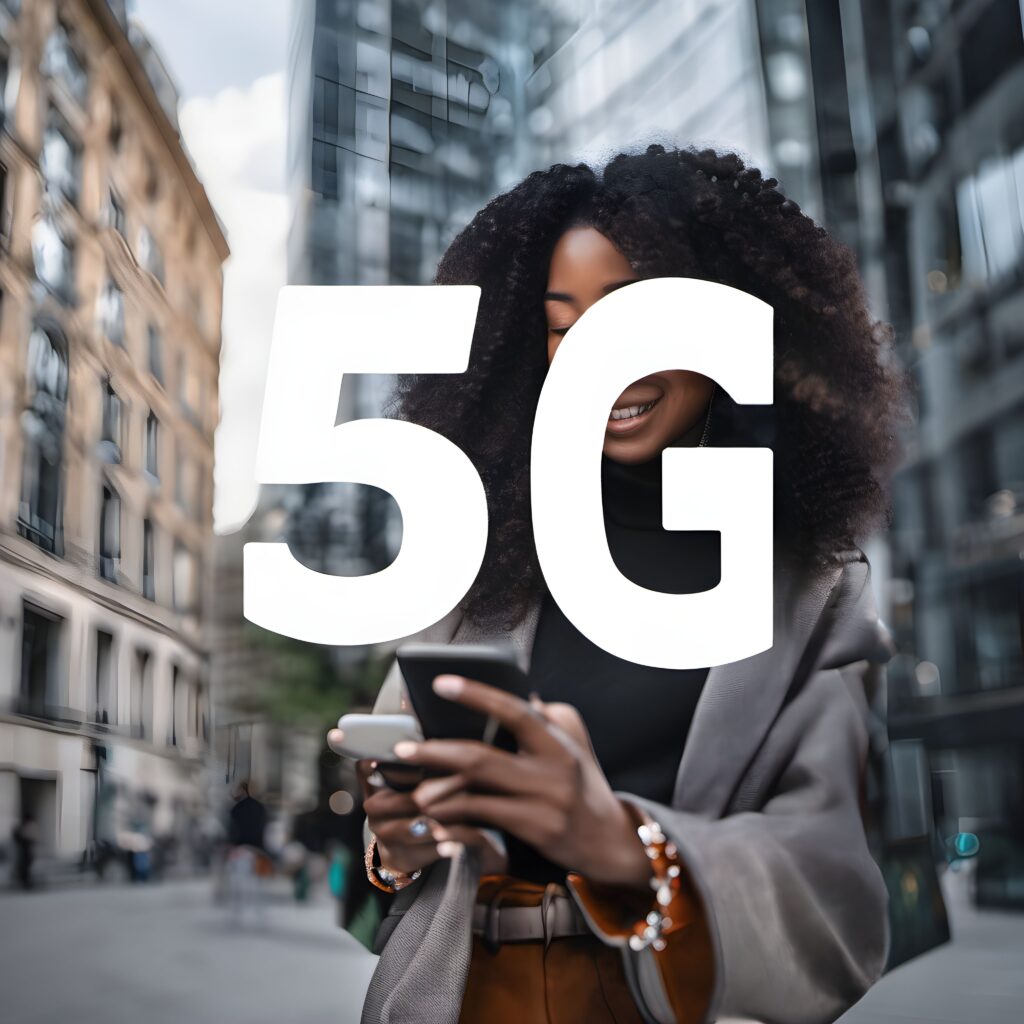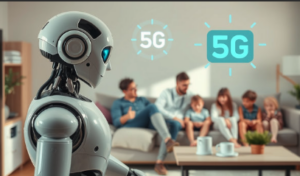The Rise of 5G Technology: How It’s Changing Connectivity

In today’s fast-paced, tech-driven world, connectivity is more essential than ever. From smartphones and the Internet of Things (IoT) to autonomous vehicles and smart cities, our reliance on fast, reliable networks has grown exponentially. Enter 5G technology, the fifth generation of mobile network connectivity, which promises to dramatically change the way the world communicates. Offering ultra-fast speeds, low latency, and a more reliable connection, 5G is set to revolutionize how industries operate, enhance consumer experiences, and open doors to new technological innovations.
The transition from 4G to 5G is more than just a speed upgrade; it is the foundation for the next era of technological advancements. While 4G paved the way for smartphones and mobile internet, 5G provides the infrastructure needed for real-time, high-performance applications. The rise of 5G will bring significant changes to connectivity, affecting everything from everyday internet use to the global economy. This article explores the key aspects of 5G technology, its impact on industries, the global rollout, and the future opportunities and challenges it presents.
Understanding 5G Technology
To grasp the significance of 5G, it is essential to first understand how it works. 5G is a sophisticated, high-speed wireless network designed to meet the growing demand for faster data transfer, increased connectivity, and low-latency communication. Its core innovation lies in the use of millimeter waves—higher frequencies of radio waves that can transmit more data at faster speeds compared to the lower frequencies used in 4G.
In comparison to its predecessors, 5G boasts several key enhancements:
-
Higher Speeds: While 4G networks can offer download speeds of up to 1 Gbps, 5G can theoretically reach speeds of up to 10 Gbps. This increase in speed allows for better experiences in mobile data, video streaming, gaming, and other bandwidth-heavy activities.
-
Lower Latency: Latency refers to the delay between sending and receiving data. 5G significantly reduces latency to as low as 1 millisecond, ensuring near-instantaneous data transfer, which is essential for applications like autonomous driving, remote surgery, and real-time gaming.
-
Increased Capacity: With 5G, massive MIMO (Multiple Input, Multiple Output) technology allows for the simultaneous transmission of data to and from multiple devices. This drastically improves network capacity, which is critical in supporting the growing number of connected devices.
5G technology is designed to work across various spectrum bands—sub-6 GHz, millimeter waves, and more. By utilizing small cell networks, which use lower-power transmitters in densely populated areas, 5G can deliver the necessary capacity and performance required for its promises.
Global Rollout of 5G: Current Status
As of 2025, the deployment of 5G networks is underway, with different countries progressing at varying speeds. Some regions, like South Korea, China, and the United States, are leading the way in terms of 5G adoption, while others are still in the early stages of implementation.
In South Korea, 5G was officially launched in 2019, making it one of the first countries to offer widespread 5G coverage. The country has since expanded its 5G network rapidly, establishing a robust infrastructure and ensuring that more cities have access to high-speed connectivity.
China has made substantial investments in 5G, with the government and telecom companies such as China Mobile and China Telecom spearheading the rollout. China aims to have 5G available in hundreds of cities by the end of 2025, reinforcing its leadership in global technology innovation. This rapid rollout is seen as a strategic move to dominate the future of global digital communications.
In the United States, telecom giants like Verizon, AT&T, and T-Mobile have launched 5G networks across various cities. However, the rollout is still a work in progress, with rural areas and less densely populated regions being slower to receive the benefits of 5G.
Despite these advancements, challenges persist. Building the required infrastructure for 5G, such as the installation of small cells and fiber-optic networks, is an expensive endeavor. Additionally, the allocation of spectrum—necessary for high-speed 5G connectivity—requires cooperation from governments and regulatory bodies.
The Impact of 5G on Industries
5G’s ability to offer lightning-fast speeds, low latency, and large-scale connectivity is set to fundamentally change several industries. This transformation will not only affect how consumers interact with technology but will also drive innovation across various sectors.
1. Healthcare
In healthcare, 5G is poised to significantly improve patient outcomes by enabling real-time remote monitoring, telemedicine, and even remote surgeries. Through telehealth, patients in remote areas can consult doctors, receive diagnoses, and undergo medical procedures—all through connected devices powered by 5G.
For instance, robotic surgeries could become commonplace, where a surgeon in one location can operate on a patient miles away via robotic arms. With 5G’s low latency and high bandwidth, these procedures can be performed with minimal delay, ensuring precision and safety.
In addition, wearable health devices, such as smartwatches and fitness trackers, will collect data from patients continuously, allowing doctors to monitor vital signs in real-time and adjust treatments as necessary. This continuous, connected monitoring can greatly reduce hospital readmissions and improve overall healthcare efficiency.
2. Automotive and Transportation
5G will play a pivotal role in the development of autonomous vehicles. These vehicles rely on constant communication with surrounding infrastructure—such as traffic lights, road signs, and other vehicles—in order to make real-time decisions. 5G’s ultra-low latency will ensure that vehicles can react almost instantly to their environment, improving safety and reducing accidents.
Moreover, 5G will facilitate the development of smart traffic systems. By connecting vehicles and infrastructure, traffic flow can be optimized, reducing congestion, improving fuel efficiency, and lowering emissions. Autonomous public transportation, such as buses and trains, will also benefit from 5G’s connectivity, making transportation systems more efficient and accessible.
3. Manufacturing and Industry 4.0
The manufacturing sector stands to benefit immensely from 5G technology. With the rise of Industry 4.0, smart factories equipped with IoT devices, sensors, and AI-powered systems will use 5G to optimize production lines, monitor machinery, and ensure smooth operation.
One of the key applications is predictive maintenance. 5G-enabled IoT devices can monitor the condition of machinery and identify potential issues before they lead to costly breakdowns. By receiving real-time data from machines, manufacturers can schedule maintenance only when necessary, leading to cost savings and minimizing downtime.
Additionally, augmented reality (AR) will transform the way workers interact with machinery, helping them troubleshoot problems or repair complex systems with the assistance of real-time virtual guides.
4. Entertainment and Media
Entertainment is another sector poised to benefit from 5G technology. With its ability to handle high-bandwidth applications, 5G will enable seamless streaming of high-definition videos and immersive experiences in virtual reality (VR) and augmented reality (AR).
Imagine watching a movie in 8K resolution without buffering or lag, or experiencing a live concert in 360-degree VR from the comfort of your home. 5G will make these experiences possible, offering content creators and consumers a whole new world of entertainment.
In gaming, 5G will support cloud gaming platforms, enabling gamers to stream high-quality, resource-intensive games directly to their devices without the need for powerful hardware. This could democratize access to high-end gaming, allowing users to play graphically intensive games on smartphones and low-cost devices.
5. Retail and E-Commerce
Retail and e-commerce industries will also be transformed by 5G. Retailers will be able to offer personalized shopping experiences using augmented reality. Consumers will be able to try on clothes virtually or see how furniture fits in their homes before purchasing, all thanks to the fast, responsive nature of 5G networks.
Additionally, 5G-enabled smart stores will allow consumers to shop more efficiently. Connected devices, including inventory sensors and automated checkout systems, will streamline the shopping experience, making it more convenient and personalized.
5G and the Internet of Things (IoT)
One of the most significant aspects of 5G is its ability to support the Internet of Things (IoT). IoT refers to the network of connected devices, from smart refrigerators to industrial sensors. With billions of devices expected to connect to the internet in the coming years, 5G will provide the necessary infrastructure to support this hyperconnected future.
The low latency and high bandwidth of 5G will enable real-time communication between devices, allowing for better resource management, enhanced automation, and improved user experiences. In agriculture, for example, IoT devices connected by 5G can monitor crop conditions, optimize irrigation, and even predict harvest times. Similarly, in smart cities, 5G-powered IoT devices will monitor traffic patterns, manage energy consumption, and improve public safety.
The Future of 5G Technology
Looking ahead, the potential of 5G goes far beyond its current applications. 6G technology is already in the planning stages, with researchers exploring concepts that will further expand the capabilities of mobile networks. This next generation of wireless technology promises to deliver even faster speeds, more reliable connectivity, and the potential for fully immersive experiences, such as holographic communication and AI-driven applications.
While 5G is already transforming industries, its full impact will be realized over the next decade as more use cases emerge and infrastructure continues to be rolled out globally.
Security Concerns and 5G
As with any technological advancement, 5G comes with its set of challenges—particularly in the realm of cybersecurity. The increased number of connected devices, along with the reliance on 5G for critical infrastructure, makes security a top concern. Vulnerabilities in the 5G network could lead to significant risks, such as data breaches, hacking, and cyberattacks.
Governments and telecom providers are already working to implement stringent security protocols for 5G networks. These include end-to-end encryption, network slicing, and the development of more secure hardware components. Nevertheless, ongoing collaboration between private sector and regulatory bodies will be essential to ensure that 5G remains secure and resilient.
The rise of 5G technology is set to change the way we connect to the world around us. By enabling faster speeds, lower latency, and more reliable connectivity, 5G will drive innovations across industries—from healthcare and manufacturing to entertainment and retail. While challenges remain in terms of global rollout, infrastructure investment, and security concerns, the promise of 5G is undeniable. As 5G networks continue to expand, we can expect a future of more connected, efficient, and immersive experiences that will shape the next generation of technology and digital innovation.
Feel free to check out our other website at : https://synergypublish.com




